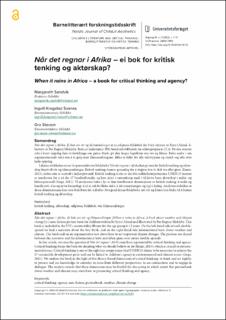Når det regnar i Afrika–ei bok for kritisk tenking og aktørskap?
Peer reviewed, Journal article
Published version
Permanent lenke
https://hdl.handle.net/11250/3072304Utgivelsesdato
2023Metadata
Vis full innførselSamlinger
Originalversjon
https://doi.org/10.18261/blft.14.1.5Sammendrag
Når det regnar i Afrika. Ei bok om vêr og klimaendringar er ei sakprosa-bildebok for barn skriven av Erna Osland, illustrert av Per Ragnar Møkleby. Boka er innlemma i FNs berekraftsbibliotek for aldersgruppa 6–12 år. På den venstre sida i kvart oppslag finn vi forteljinga om guten Styrk, på den høgre fagtekstar om vêr og klima. Boka endar i ein argumenterande tekst om å ta grep mot klimaendringane. Bilda er felles for alle teksttypane og strekk seg ofte over heile oppslag. I denne artikkelen reiser vi spørsmålet om bildeboka Når det regnar i Afrika kan gi rom for kritisk tenking og aktørskap knytt til vêr og klimaendringar. Kritisk tenking dannar grunnlag for å avgjere kva vi skal tru eller gjere (Ennis, 2015), noko som er sentralt i miljøspørsmål. Kritisk tenking er ein av dei åtte nøkkelkompetansane UNESCO meiner er naudsynte for å nå dei 17 berekraftsmåla, og kan sjåast i samanheng med å tilskrive barn aktørskap i miljø- og klimaspørsmål (Goga, 2021). Vi analyserer boka i lys av fem teoribaserte dimensjonar av kritisk tenking: å tenke og handle rett, å ha og nytte kunnskap, å sjå ei sak frå fleire sider, å sjå samanhengar, og å gå i dialog. Analysen avdekker at desse dimensjonane kan vere fruktbare for å drøfte i kva grad denne bildeboka om vêr og klima kan bidra til å fremje kritisk tenking og aktørskap.
This book is included in the UN’s sustainability library for the age group 6-12 years. On the left-hand side of each double-spread we find a narrative about the boy Styrk, and on the right-hand side informational texts about weather and climate. The book ends in an argumentative text about how to act to prevent climate changes. The pictures are shared between the narrative and the informational texts and often spans over entire double-spreads. In this article, we raise the question if Når det regner i Afrika may have a potential for critical thinking and agency. Critical thinking forms the basis for deciding what we should believe or do (Ennis, 2015), which is crucial to environmental issues. Critical thinking is one of the eight key competences that UNESCO claims to be necessary to achieve the 17 sustainable development goals and can be linked to children’s agency in environmental and climate issues (Goga, 2021). We analyze the book in the light of five theory-based dimensions of critical thinking: to think and act rightly, to possess and use knowledge, to consider an issue from different perspectives, to see connections and to engage in dialogue. The analysis reveals that these dimensions may be fruitful for discussing to which extent this picturebook about weather and climate may contribute to promoting critical thinking and agency.

